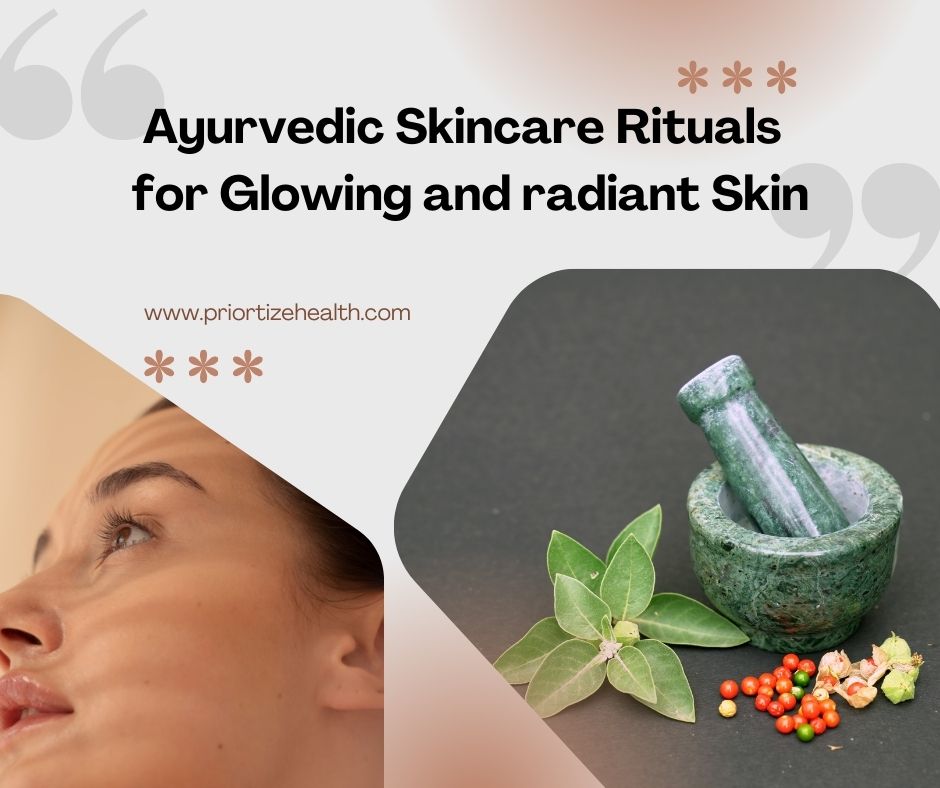
Ayurvedic Skincare Rituals for Glowing Skin
In our modern world, we have an array filled with skincare products promising radiant skin. It’s easy to overlook the ancient wisdom of Ayurveda. Originating in India thousands of years ago, Ayurveda is more than a system of medicine. It’s a holistic approach to life, emphasizing balance and harmony within the body, mind, and spirit. When it comes to skincare, Ayurveda offers timeless rituals. It not only nourishes the skin but also promotes inner well-being, resulting in a natural, radiant glow.
Ayurveda recognizes that each individual possesses a unique constitution, or “dosha.” It comprises of the elements of air (Vata), fire (Pitta), and earth (Kapha). Imbalances in these doshas can manifest in various skin issues. They range from dryness and dullness to excess oiliness and inflammation. Ayurvedic skincare rituals aim to restore balance to these energies. It allows the skin to thrive in its natural state of health and radiance.
The Ayurvedic Skincare Routine:
A) Daily Cleansing:
Daily cleansing is the cornerstone of any skincare routine. In Ayurveda, it holds particular significance. The aim of daily cleansing is not only to remove dirt, impurities, and makeup from the skin. But it also purifies and rejuvenates the skin without disrupting its natural balance.
Choice of Cleanser: Ayurveda emphasizes the use of natural ingredients. They are gentle yet effective in cleansing the skin. Some Ayurvedic cleansers include:
- Rose Water: It is popular for its soothing and hydrating properties. Rose water cleanses the skin while balancing its pH levels. It’s particularly beneficial for sensitive or dry skin types.
- Neem: Neem is popular in Ayurveda for its antibacterial and anti-inflammatory properties. Neem-based cleansers help cleanse the skin. It also addresses issues like acne and inflammation.
- Turmeric: It contains powerful antioxidant and anti-inflammatory properties. People use turmeric in Ayurvedic cleansers to purify and brighten the skin, leaving it glowing and radiant.
Cleansing Technique:
In Ayurveda, the cleansing process is therapeutic. It involves mindful techniques that promote relaxation and rejuvenation. Here’s how to perform the daily cleansing ritual:
- Gentle Massage: Start by moistening your face with water. Apply the cleanser of your choice to your fingertips. Massage the cleanser onto your skin using circular motions. Pay special attention to areas prone to oiliness or impurities.
- Rinse with Warm Water: After massaging the cleanser rinse it off with lukewarm water. Avoid using hot water, as it can strip the skin of its natural oils and lead to dryness and irritation.
- Pat Dry: Once you’ve rinsed off the cleanser, pat your skin dry with a soft towel. Avoid rubbing or pulling on the skin, as this can cause unnecessary friction and damage.
Frequency: Perform cleansing every morning and evening as part of your skincare routine. Cleansing in the morning helps remove sweat, oil, and impurities that have accumulated overnight. The evening cleansing removes makeup, dirt, and pollutants accumulated throughout the day.
Benefits:
Daily cleansing offers a multitude of benefits for the skin, including:
- Purification: Remove dirt, oil, and impurities from the skin. Daily cleansing helps purify and detoxify the pores, preventing congestion and breakouts.
- Balance: Ayurvedic cleansers maintain the skin’s natural pH balance. They ensure that skin stays hydrated, nourished, and healthy.
- Stress Relief: The act of cleansing the skin can be a therapeutic ritual. It promotes relaxation and mindfulness. This helps to reduce stress and promote well-being.
B) Exfoliation:
Exfoliation is a crucial step in any skincare routine, including Ayurvedic skincare. It involves the removal of dead skin cells from the surface of the skin. This reveals smoother, brighter, and more radiant skin underneath. In Ayurveda, exfoliation is a way to promote healthy skin. It encourages cell turnover and enhances the skin’s natural radiance.
Importance of Exfoliation in Ayurveda:
Exfoliation is essential in Ayurvedic skincare for several reasons:
- Removal of Dead Skin Cells: Dead skin cells can accumulate on the skin’s surface. This leads to dullness, rough texture, and clogged pores. Exfoliation helps slough off these dead cells, revealing fresh, rejuvenated skin underneath.
- Stimulation of Cell Turnover: Exfoliation stimulates the skin’s natural renewal process. It encourages the growth of new, healthy skin cells. This helps improve the skin’s texture, tone, and appearance.
- Enhanced Absorption of Skincare Products: By removing the layer of dead skin cells, exfoliation allows skincare products to penetrate deep into the skin. This maximizes the effectiveness of exfoliation.
Types of Exfoliants Used in Ayurveda:
In Ayurvedic skincare, exfoliants contain natural ingredients that are gentle yet effective. Some common Ayurvedic exfoliants include:
- Chickpea Flour (Besan): Chickpea flour is a staple ingredient in Ayurvedic skincare. This is due to its mild exfoliating properties. It helps remove dead skin cells and excess oil while leaving the skin soft and smooth.
- Oatmeal: Oatmeal has soothing and moisturizing properties, making it ideal for sensitive or dry skin. It exfoliates the skin while providing hydration and relief from irritation.
- Sandalwood Powder: Sandalwood powder has antimicrobial and anti-inflammatory properties. This makes it beneficial for acne-prone or sensitive skin. It helps unclog pores, reduces inflammation, and promotes a clear complexion.
Exfoliation Techniques in Ayurveda:
In Ayurvedic skincare, the process of exfoliation includes gentle circular motions. It avoids causing irritation or damage to the skin. Here’s how to exfoliate your skin:
- Preparation: Start by moistening your skin with water. This will soften the skin and prepare it for exfoliation.
- Application: Apply the exfoliant to your fingertips or a clean washcloth. Massage the exfoliant onto your skin using circular motions. Focus on areas of congestion or roughness.
- Rinse: Once you’ve exfoliated all areas of your skin, rinse it off with lukewarm water. Pat your skin dry with a soft towel.
- Moisturize: After exfoliating, it’s essential to moisturize your skin. This will replenish lost hydration and prevent dryness. Choose a moisturizer that suits your skin type and apply it to your skin.
Frequency of Exfoliation:
The frequency of exfoliation depends on your skin type and sensitivity. In general, it’s recommended to exfoliate 1-3 times per week for most skin types. But, if you have sensitive or skin, you may need to exfoliate less to avoid over-exfoliation.
Benefits of Exfoliation in Ayurveda:
Exfoliation offers many benefits for the skin, including:
- Improved Texture: Exfoliation helps smooth rough patches and uneven texture. It leaves the skin soft and velvety.
- Brightened Complexion: Exfoliation removes dead skin cells. This helps to reveal a brighter, more luminous complexion.
- Prevention of Breakouts: Exfoliation helps unclog pores. It prevents the formation of blackheads, whiteheads, and acne breakouts.
- Enhanced Absorption: Exfoliation allows skincare products to penetrate deep into the skin. It maximizes their efficacy and benefits.
C) Nourishment with Oils:
In Ayurvedic skincare, nourishing the skin with oils is a fundamental practice. Ayurveda recognizes the importance of natural oils. It maintains the skin’s health, hydration, and radiance. Nourishing the skin with oils moisturizes and protects the skin. It also promotes balance and harmony within the body and mind.
Importance of Nourishing with Oils in Ayurveda:
Ayurveda views the skin as a reflection of one’s health and well-being. According to Ayurvedic principles, there is close connection of the doshas, or elemental energies, within the body. Nourishing the skin with oils helps maintain the balance of these doshas. It also promotes optimal skin health and vitality.
Choice of Oils:
Ayurvedic skincare emphasizes the use of natural, plant-based oils. They should suit to individual skin types and doshas. Some oils in Ayurvedic skincare include:
- Sesame Oil: Sesame oil is a popular choice in Ayurveda. This is due to its nourishing and warming properties. It is rich in antioxidants, vitamins, and fatty acids. This makes it ideal for all skin types, especially dry or mature skin.
- Coconut Oil: Coconut oil is popular for its moisturizing and antimicrobial properties. It helps hydrate the skin while protecting it from environmental stressors.
- Almond Oil: Almond oil is lightweight that absorbs by the skin easily. This making it suitable for all skin types, including sensitive or oily skin. It is rich in vitamins and minerals that nourish and rejuvenate the skin, leaving it soft and supple.
- Jojoba Oil: Jojoba oil resembles the skin’s natural sebum. This makes the oil an excellent choice for balancing oil production and maintaining hydration levels. It is non-comedogenic and suitable for all skin types.
- Rosehip Seed Oil: Rosehip seed oil is rich in essential fatty acids and antioxidants. This makes it ideal for nourishing and repairing the skin. It helps improve skin texture, reduce inflammation, and fade scars and blemishes.
Application Technique:
In Ayurvedic skincare, the application of oils involves gentle massage techniques. It promotes relaxation, circulation, and absorption. Here’s how to apply oils to the skin:
- Preparation: Start by cleansing your face with a gentle Ayurvedic cleanser. It will remove dirt, makeup, and impurities from the skin. Pat your skin dry with a soft towel.
- Dispensing the Oil: Pour a small amount of your chosen oil into the palm of your hand. Rub your palms together to warm the oil and distribute it in an even manner.
- Massage: Using gentle, upward strokes, massage the oil onto your face and neck. Avoid the delicate area around the eyes. Pay attention to areas of dryness, tension, or congestion. Massage the oil into the skin using circular motions.
- Absorption: Allow the oil to absorb into your skin for several minutes. Allow its nourishing properties to penetrate deep in the skin layers. You can leave the oil on overnight for an intensive treatment. Rinse it off with lukewarm water after 10-15 minutes.
Benefits of Nourishing with Oils:
Nourishing the skin with oils offers benefits to skin and well-being, including:
- Hydration: Oils help replenish moisture levels in the skin. It prevents dryness, flakiness, and dehydration.
- Protection: Oils form a protective barrier on the skin’s surface. The oil shields the skin from environmental stressors. They are pollution, UV radiation, and harsh weather conditions.
- Nourishment: Oils are rich in vitamins, minerals, and fatty acids. It nourishes and rejuvenates the skin, promoting a healthy, radiant complexion.
- Balance: Ayurvedic oils help balance the doshas within the body. It promotes our harmony and well-being.
D) Herbal Masks and Packs:
In Ayurvedic skincare, herbal masks and packs play a vital role. They promote a healthy and radiant skin. These formulations harness the power of natural herbs, plants, and other botanical ingredients. These ingredients help to nourish, rejuvenate, and balance the skin. Herbal masks and packs are tailored to individual skin types and doshas. They address specific concerns such as dryness, acne, inflammation, or dullness.
Importance of Herbal Masks and Packs in Ayurveda:
Herbal masks and packs are an integral part of Ayurvedic skincare. It is due to their ability to deliver potent nutrients and therapeutic properties to the skin. These formulations contain careful selection of herbs and ingredients. They work in a synergistic manner to address various skin concerns. This promotes balance and harmony within the body and mind.
Choice of Herbs and Ingredients:
Ayurvedic herbal masks and packs feature a wide range of herbs and ingredients. They are selected for their specific properties and benefits. Some of these herbs and ingredients in Ayurvedic skincare include:
- Turmeric (Haridra): Turmeric is beneficial for its anti-inflammatory, antimicrobial, and antioxidant properties. It helps brighten the complexion, reduce acne and blemishes, and promote skin health.
- Neem (Nimba): Neem is popular for its antibacterial, antifungal, and antiseptic properties. It helps purify the skin and control acne and breakouts. Neem also helps to soothe inflammation and irritation.
- Sandalwood (Chandana): Sandalwood has cooling, soothing, and astringent properties. This makes it ideal for calming irritated or inflamed skin. It helps reduce redness, swelling, and excess oiliness. Sandalwood promotes a clear, radiant complexion.
- Aloe Vera (Kumari): Aloe vera is popular for its moisturizing, soothing, and healing properties. It helps hydrate the skin, reduce inflammation, and promote skin regeneration. Thus, it is beneficial for dry, sensitive, or sun-damaged skin.
- Tulsi (Holy Basil): Tulsi is beneficial in Ayurveda for its purifying and detoxifying properties. It helps cleanse the skin, remove impurities, and prevent acne and breakouts. This helps in leaving the skin clear, smooth, and radiant.
Application Technique:
People apply herbal masks and packs to clean, dry skin and left on for a specified period before being rinsed off. Here’s how to apply herbal masks and packs:
- Preparation: Start by cleansing your face with a gentle Ayurvedic cleanser. It will help to remove dirt, oil, and impurities from the skin. Pat your skin dry with a soft towel.
- Application: Apply a thin, even layer of the herbal mask or pack to your face and neck. Avoid the delicate area around the eyes. Use gentle, upward strokes to ensure even coverage.
- Relaxation: After applying the mask, take some time to relax and unwind. The ingredients will work their magic. You can lie down, close your eyes, and listen to soothing music. Practice deep breathing exercises to enhance the experience.
- Rinsing: After 10-20 minutes, rinse off the mask with lukewarm water. Use gentle, circular motions to massage the skin and remove any residue.
Benefits of Herbal Masks and Packs:
Herbal masks and packs offer a wide range of benefits for the skin, including:
- Deep Cleansing: Herbal masks help remove dirt, oil, and impurities from the skin. It leaves the skin clean, clear, and refreshed.
- Nourishment: Herbal ingredients provide essential nutrients, vitamins, and antioxidants. They nourish and rejuvenate the skin, promoting a healthy, radiant complexion.
- Balancing: Herbal masks help balance the doshas within the body. It restores harmony and vitality to the skin and promotes well-being.
- Targeted Treatment: We can customize herbal masks to address specific skin concerns. They are acne, dryness, inflammation, or aging, providing targeted treatment and relief.
E) Balancing Toners:
In Ayurvedic skincare, balancing toners is an essential step. They help in promoting healthy, radiant skin. These toners contain natural ingredients that help balance the skin’s pH levels. It tightens the pores, soothes inflammation, provides hydration and nourishment. Balancing toners plays a crucial role in preparing the skin for further skincare treatments. It helps in maintaining health and vitality.
Importance of Balancing Toners in Ayurveda:
By balancing the skin’s pH, toners help keep the skin hydrated and nourished. It protects the skin from external aggressors, promoting a clear, radiant complexion.
Choice of Ingredients:
Ayurvedic balancing toners feature a variety of natural ingredients. We should choose them for their ability to soothe, hydrate, and balance the skin. Some ingredients in Ayurvedic toners include:
- Rose Water: Rose water has soothing, hydrating, and toning properties. It helps balance the skin’s pH levels, tighten pores. The water reduces redness and inflammation, leaving the skin refreshed and revitalized.
- Witch Hazel: Witch hazel is a natural astringent. It helps to tighten pores, reduce excess oiliness, and soothe inflammation and irritation. Witch Hazel balances the skin’s pH levels while providing a refreshing, cooling sensation.
- Holy Basil (Tulsi): Holy basil has purifying and detoxifying properties. It helps cleanse the skin, remove impurities, and soothe inflammation. This promotes a clear, radiant complexion.
- Chamomile: Chamomile has calming and soothing properties. This makes it ideal for sensitive or irritated skin. It helps reduce redness, inflammation, and irritation while promoting relaxation and stress relief.
- Aloe Vera: Aloe vera is popular for its moisturizing, soothing, and healing properties. It helps hydrate the skin, reduce inflammation, and promote skin regeneration. This makes it beneficial for all skin types.
Application Technique:
We can apply balancing toners to clean, dry skin after cleansing and before applying moisturizer or other skincare products. Here’s how to apply balancing toners:
- Preparation: Start by cleansing your face with a gentle Ayurvedic cleanser. This will remove dirt, oil, and impurities from the skin. Pat your skin dry with a soft towel.
- Dispensing the Toner: Pour a small amount of the balancing toner onto a cotton pad or into the palm of your hand. Pat or swipe the toner onto your face and neck, avoiding the delicate area around the eyes.
- Massage: Using gentle, upward strokes, massage the toner into your skin. Pay attention to areas of congestion, dryness, or irritation. Apply extra toner as needed.
- Follow-up: Allow the toner to dry before applying any additional skincare products. They can be serums, moisturizers, or sunscreens.
Benefits of Balancing Toners:
Balancing toners offer a wide range of benefits for the skin, including:
- Restoring pH Balance: Balancing toners help restore the skin’s natural pH levels. These levels may disrupt by harsh cleansers or environmental stressors.
- Tightening Pores: Toners help tighten pores, reducing their appearance and preventing congestion and breakouts.
- Hydration: Toners provide hydration and nourishment to the skin. This keeps the skin soft, supple, and refreshed.
- Soothing Irritation: Toners help soothe inflammation and irritation, reducing redness and discomfort. It promotes a calm, clear complexion.
F) Mindful Lifestyle Practices:
In Ayurvedic skincare, the concept of beauty extends beyond external treatments and products. It encompasses a holistic approach to well-being that includes mindful lifestyle practices. These practices focus on nurturing not only the skin but also the body, mind, and spirit. It promotes balance, harmony, and vitality from within.
Importance of Mindful Lifestyle Practices in Ayurveda:
Ayurveda recognizes the intimate connection between the mind, body, and spirit. It understands that imbalances in one aspect of life can manifest as skin issues and other health problems. Mindful lifestyle practices aim to cultivate awareness, balance, and harmony in all aspects of life. It promotes well-being and radiant skin from the inside out.
Key Mindful Lifestyle Practices:
- Yoga: Yoga is a holistic practice that combines physical postures (asanas), breathwork (pranayama), and meditation. It helps to promote flexibility, strength, and relaxation. Regular yoga practice helps reduce stress, improve circulation, and balance the body’s energy systems. This contributes to healthy, glowing skin.
- Meditation: Meditation is a powerful tool for cultivating inner peace, clarity, and presence. By quieting the mind and turning inward, meditation helps reduce stress, anxiety, and negative emotions. It promotes a sense of calm and well-being that radiates outward through the skin.
- Healthy Diet: Ayurveda emphasizes the importance of a balanced diet. It nourishes the body and supports health. A diet rich in fresh fruits, vegetables, whole grains, and lean proteins. It provides essential nutrients, antioxidants, and hydration that promote radiant skin from within.
- Adequate Sleep: Quality sleep is essential for skin health and regeneration. During sleep, the body repairs and rejuvenates itself, including the skin. Aim for 7-9 hours of restful sleep each night to promote optimal skin health and vitality.
- Stress Management: Chronic stress can have a detrimental effect on the skin. This leads to inflammation, breakouts, and premature aging. Incorporate stress-reducing practices such as deep breathing, mindfulness, and relaxation techniques into your daily routine. It will help to promote a calm, balanced state of mind.
- Nature Connection: Spending time in nature nourishes the mind, body, and spirit. It can be taking a walk in the park, gardening, or sitting outside and soaking up the sun. Connecting with nature helps reduce stress, boost mood, and promote well-being.
Integration into Daily Life:
Mindful lifestyle practices are not occasional activities but ongoing habits. We should integrate them into our daily life. Here’s how to incorporate these practices into your routine:
- Start your day with a few minutes of meditation or deep breathing exercises to set a positive tone for the day.
- Practice yoga to keep your body flexible, strong, and balanced.
- Eat a balanced diet that includes plenty of fresh, whole foods and hydrating fluids.
- Focus on quality sleep by establishing a relaxing bedtime routine. Create a sleep-friendly environment.
- Take regular breaks throughout the day to relax, stretch, or go for a walk.
- Cultivate gratitude and mindfulness by journaling or practicing daily affirmations.
Benefits of Mindful Lifestyle Practices:
Mindful lifestyle practices offer many benefits for health and well-being, including:
- Reduced Stress: Mindful practices help reduce stress levels. It promotes a sense of calm and relaxation that benefits the skin and body.
- Improved Sleep: Quality sleep is essential for skin health and regeneration. Mindful practices help promote restful, rejuvenating sleep.
- Enhanced Mood: Mindful practices boost mood and emotional well-being. This fosters a positive outlook that radiates through the skin.
- Increased Resilience: By cultivating awareness and presence, mindful practices help build resilience to life’s challenges. It promotes inner strength and vitality.
FAQ’s:
Ans: To be attractive according to Ayurveda, focus on inner balance and vitality. Practice mindful lifestyle habits such as yoga and meditation. Eat a nourishing diet to promote well-being. Nourish your skin with natural oils, herbal masks, and balancing toners. Focus on adequate sleep, stress management, and connection with nature to enhance inner radiance. We should harmonize our mind, body, and spirit through Ayurvedic principles. This will help you to cultivate an authentic attractiveness that emanates from within. It will reflect health, vitality, and inner harmony.
Ans: Achieve radiant skin naturally by adopting Ayurvedic skincare rituals. Start with daily cleansing using gentle, natural ingredients like rose water or neem. Exfoliate with ingredients such as chickpea flour or oatmeal to remove dead skin cells. Nourish your skin with oils like sesame or almond through gentle massage. Treat your skin to herbal masks tailored to your dosha. Balance pH levels with toners containing rose water or witch hazel. Embrace a mindful lifestyle with yoga and meditation. Eat a balanced diet for inner radiance that shines through.
Ans: In Ayurveda, we can get glowing skin by balancing doshas through holistic practices. Start with gentle cleansing using natural ingredients like rose water. Exfoliate with chickpea flour or sandalwood powder to remove dead skin cells. Nourish skin with oils such as coconut or almond through massage. Use herbal masks customized to your dosha for deep nourishment. Balance skin’s pH with toners containing rose water or witch hazel.






1 Comment
[…] their effectiveness. For best results, follow the product’s guidelines. Incorporate other skincare steps into your […]